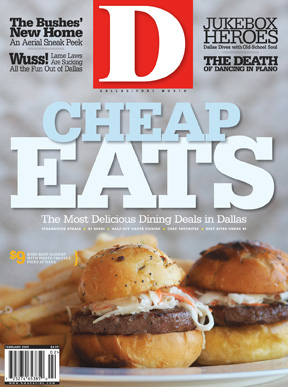 |
| LIVE AND LET DIE: Director Mark Roglán has brought the“lost, enigmatic culture” of the Etruscans to the Meadows. photography by Cindy James |
It’s hard to find a cemetery in this town. The dead are tucked away in secret gardens here. Of course, most of us don’t mind. We don’t want to think of dying, or of what we will leave behind. It’s odd, then, that so much death has come to Dallas lately: first the Crow Collection’s “Tending the Afterlife,” then the DMA’s “Tutankhamun,” and now the Meadows Museum’s “From the Temple and the Tomb: Etruscan Treasures from Tuscany.”
The last one is perhaps the oddest. Why is the SMU museum—which contains, says its director Mark Roglán, “one of the greatest” collections of Spanish art outside of Spain—hosting an exhibit about Etruscans, who came from ancient Italy and Corsica? For one, it’s cashing in on the city’s current fascination with ars moriendi—“the art of dying.” For another, SMU archeologist Dr. Greg Warden has been digging at an Etruscan settlement site, Poggio Colla, in Tuscany, for the past 15 years. The exhibit dovetails with his work there. And although “From the Temple and the Tomb” doesn’t hail from Warden’s dig site—it’s from the nearby Florence Archeological Museum—a downstairs exhibit at the Meadows, “New Light on the Etruscans: Fifteen Years of Excavation at Poggio Colla,” features some of Warden’s work.
Yet there’s a greater question here about the Meadows and its role. At its spot on Bishop Boulevard for only eight years, it’s already on its third director. Coup-ridden countries rarely undergo such quick executive shifts. The Meadows’ changes are partially due to SMU’s desire to reinvent itself. But when Ted Pillsbury stepped down as director in 2005, outcries from university professors lauded Pillsbury, who had professionalized the Meadows. The museum was certainly at a crossroads. That dissent eventually faded once Roglán, a native Spaniard, was brought in to head the museum.
This is partly because of the way Roglán interprets the museum’s mission. When I ask him if the Meadows’ location outside the Arts District obscures its visibility, he says that, to the contrary, it connects the area’s museums. Its 2007 exhibit “Balenciaga and His Legacy” borrowed works from the University of North Texas’ Texas Fashion Collection. Earlier last year, the Museum of Nature & Science hosted an exhibit on a Meadows show of Fernando Gallego’s medieval altarpiece panels. The Kimbell had examined the panels under infrared for two years, and the science museum then used them to discuss “the science of art.”
In fostering such connections, Roglán clearly appreciates exhibits that give a “broader context.” Pieces should be seen universally, since no culture exists in a vacuum.
“Art is porous, erasing frontiers and borders,” he says. “You can’t have Joan Miró without Alexander Calder, or John Singer Sargent without Joaquin Sorolla.” Roglán’s Meadows is interdisciplinary—scientists, art historians, literature professors, and other academics combine their studies to discuss “the object.” From this exchange, students become docents themselves. If the Meadows is a Spanish art museum, its interests are global.
Thus, the Etruscans. “They’re a lost, enigmatic culture, with lots of romance to them,” says Warden, explaining their appeal to the general public. Due to Roman invasions, the Etruscans disappeared around 50 B.C., but they’re remembered for other reasons, Warden says. For one: Etruscan women held extraordinary powers. And Etruscans were the foremost metal workers of the Mediterranean, making very elegant objects with a great sense of design. At the exhibit, gold jewelry, candelabras, armor, and incense-burners prove their talent.
“Etruscans were considered the most religious people of the ancient Mediterranean,” Warden says, “absolutely obsessed with ritual.” The Etruscans’ fixation on the afterlife—their tombs contain 90 percent of all found Etruscan objects—helps us imagine their lives more fully. And this exhibit, accompanied by a series of lectures in February (with more scheduled for spring), ushers in a new era for their study. When the museum’s freight elevator takes one of the pieces to the upper galleries—a 4-foot-high and 29-foot-wide classical Etruscan pediment—the Etruscans will truly transcend the underworld.
Thanks to Algur H. Meadows’ legacy, this resurrection is possible. William Jordan, the museum’s first director, began working closely with Meadows in the late ’60s. He is perhaps best remembered for discovering that many of the pre-19th-century works were “ambitiously attributed” and, by identifying and replacing suspect works, helped rebuild the collection. The result: Meadows’ endeavors have given us a city that can ship whole civilizations into its museums.
“From the Temple and the Tomb” and “New Light on the Etruscans” remind us that, sooner or later, all civilizations become footnotes. Unlike the Etruscans, Dallasites don’t iconize death, so we’re less likely to proffer cool funereal objects to archeologists in two millennia. But we can better understand the art of dying through the Meadows Museum, which, through its thoughtful, expansive approach, offers exhibits that lift the past from the ashes.
Exhibits, “From the Temple and the Tomb: Etruscan Treasures from Tuscany” and “New Light on the Etruscans: Fifteen Years of Excavation at Poggio Colla,” Jan 25–May 17, Meadows Museum; Lecture, “New Evidence for Etruscan Ritual: The Excavations at the Sanctuary of Poggio Colla,” Dr. Greg Warden, Feb 5, 6 pm, Meadows Museum; Lecture, “DNA and the Origins of the Etruscans,” Dr. Philip Perkins, Feb 12, 6 pm, Meadows Museum; Talk, “Taking the Mystery out of Ancient Metal Techniques,” Ellen Buie Niewyk, Feb 19, 6 pm, Meadows Museum; Talk, “The Etruscans in Context,” Dr. Greg Warden, Feb 20, 12:15 pm, Meadows Museum. meadows.smu.edu.





